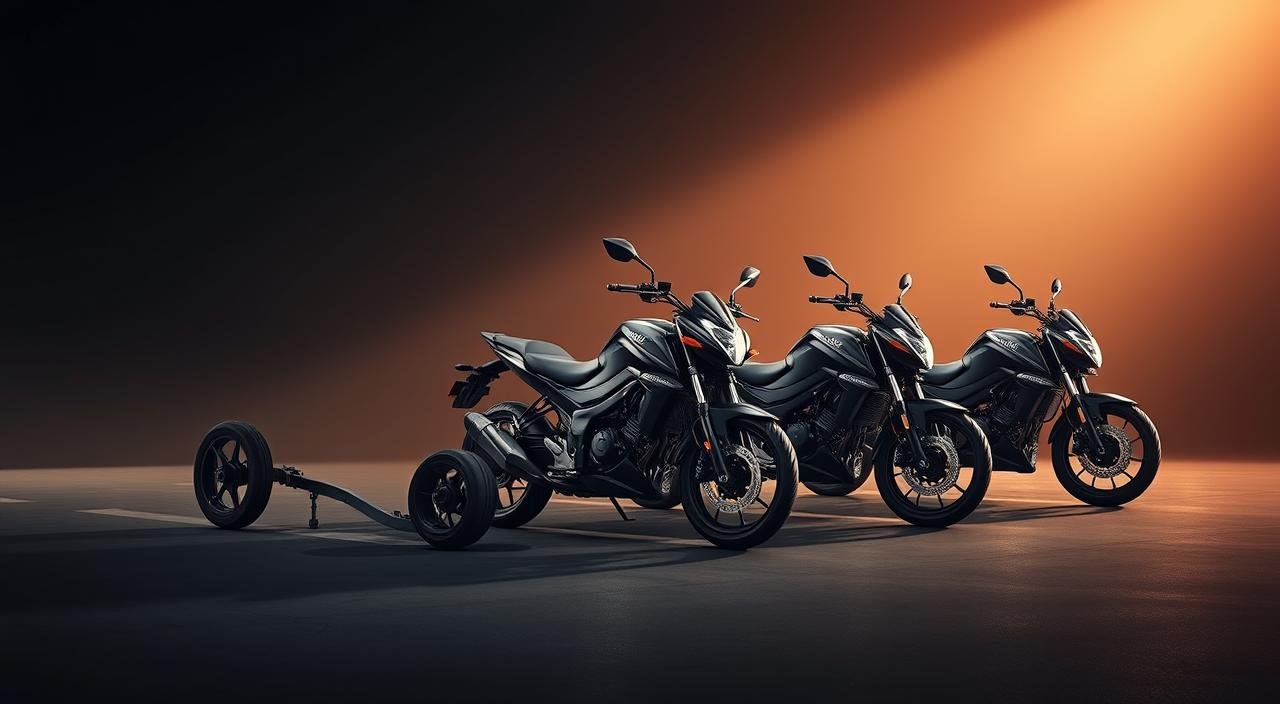
Jul
What turns a motorcycle into a cultural icon that lasts for decades? The Yamaha FZ series is a prime example of growth in the motorcycle world. It shows how a bike can change from a simple idea into a modern favorite in India.
The Yamaha FZ bike first hit Indian roads with big promises. It changed over time, showing off engineering skills and adapting to what people wanted. Each new version kept the essence that made the Yamaha FZ loved by many.
Today, the Yamaha FZ looks very different from its early days. Looking at the Yamaha FZ then and now, you see big changes in tech, design, and how it performs. From old-school carburetors to modern fuel injection, and simple gauges to digital screens, it all shows how far we’ve come.
The Indian motorcycle scene has seen the FZ series grow year by year. Each update listened to what riders said and added new looks and features. The FZ series became more than just a way to get around; it was a way to express yourself and your love for riding.
Key Takeaways
- The Yamaha FZ series transformed from a basic commuter to a premium street fighter over its lifespan
- Engine technology evolved from air-cooled carbureted systems to fuel-injected powerplants
- Design language shifted from conventional styling to aggressive, modern aesthetics
- Safety features expanded from basic braking to advanced systems with improved stopping power
- The FZ maintained its market position through consistent innovation and consumer-focused updates
- Fuel efficiency improved significantly while maintaining performance characteristics
The Birth of the Yamaha FZ Series
The Yamaha FZ series started in the early 1980s. Riders wanted bikes that were simple and powerful. Yamaha made motorcycles that were both strong and easy to use.
The FZ series quickly gained fans. These riders liked the bikes’ straightforward design and bold looks.
Initial Concept and Design
The first FZ bikes showed Yamaha’s idea of a naked sportbike. They had exposed engines and simple bodywork. This design made the bike feel more connected to the rider.
These bikes had unique round headlights and sculpted tanks. These features became key parts of the Yamaha FZ’s look.
Key Features of Early Models
Early FZ bikes had air-cooled engines and carburetors. They had basic suspension and simple instruments. This made them easy to use and maintain.
| Feature | FZ400 (1984) | FZ600 (1986) | FZ750 (1985) |
|---|---|---|---|
| Engine Type | Air-cooled, 4-cylinder | Air-cooled, 4-cylinder | Liquid-cooled, 4-cylinder |
| Displacement | 399cc | 598cc | 749cc |
| Power Output | 59 hp | 74 hp | 106 hp |
| Brakes | Front disc, rear drum | Dual front discs, rear disc | Dual front discs, rear disc |
These early models set the FZ’s reputation. They were known for reliable performance and rider-focused design.
Evolution Through the Years
The Yamaha FZ models have changed a lot over nearly 20 years. Starting in 2006, they went from simple commuter bikes to high-tech machines. Each new version brought big improvements, making the bike better in many ways.
Major Upgrades: From 2006 to Present
A big change was moving from carburetors to electronic fuel injection. This made the bike run smoother and use less fuel. The first bikes had 150cc engines, but Yamaha later added 250cc models.
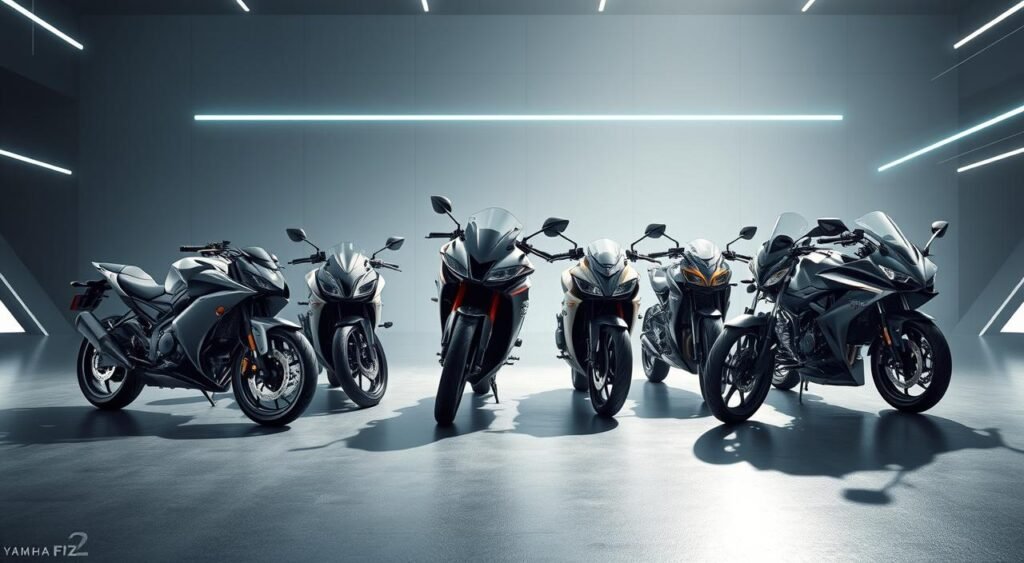
- Liquid cooling systems for better temperature management
- LED lighting for enhanced visibility
- Digital instrument clusters with ride data
- Advanced braking systems for safety
- Variable valve actuation for better performance
The 2025 FZ-S Fi shows how far Yamaha has come. It has 12.4 PS power and 13.3 Nm torque. It also gets about 60 kilometers per liter, making it very fuel-efficient.
Impact of Consumer Feedback
Rider feedback has been key in improving Yamaha FZ models. People wanted better seats, so Yamaha made them more comfortable. The FZ-S was made to look better and be more comfortable.
Younger riders asked for tech like smartphone connectivity and traction control. Yamaha listened and added these features to their bikes.
The Yamaha FZ in the American Market
The Yamaha FZ series had a big challenge when it came to the American market. In Asia, the FZ was a huge hit, but in America, riders had other ideas. Yamaha had to change its game to compete with the big names in naked bikes.
Early Reception and Sales Performance
When the FZ hit American showrooms, riders were curious. It was seen as a middle ground between beginner bikes and high-end naked bikes. The FZ-07 (MT-07) was a hit with new riders who wanted a bike that was both affordable and powerful.
The Yamaha FZ comparison with Honda’s CB series showed some interesting facts. Honda was strong in the beginner market, but Yamaha found its spot with better value and sporty looks. From 2014-2016, the FZ series grabbed 15% of the naked bike market.
Market Strategies Over Time
Yamaha’s marketing changed a lot to win over American riders. They moved from seeing the FZ as a beginner bike to a cool urban ride for more experienced riders. Their new tactics included:
- Highlighting the bike’s racing roots in ads
- Working with riding schools to show the FZ’s easy-to-learn features
- Expanding where you could find the bike, with demo rides and financing
- Building online groups to keep riders loyal
They also brought out bigger models like the FZ-09 (MT-09) for riders wanting more power but keeping the bike’s famous agility.
Engine Development: Then and Now
The Yamaha FZ bike has seen big changes in its engine over the years. It moved from simple air-cooled engines to advanced fuel-injected ones. This shows Yamaha’s dedication to new tech and meeting rider needs and emission rules in India.
Early Engine Specifications
The first Yamaha FZ had a 153cc air-cooled single-cylinder engine. It used a carburetor for fuel and made 14 PS at 7,500 RPM and 13.6 Nm torque at 6,000 RPM. Its design was simple but reliable for city rides.
These early bikes had a 2-valve SOHC setup. The carburetor was basic but worked well for city driving. Riders loved its strong mid-range and unique sound.
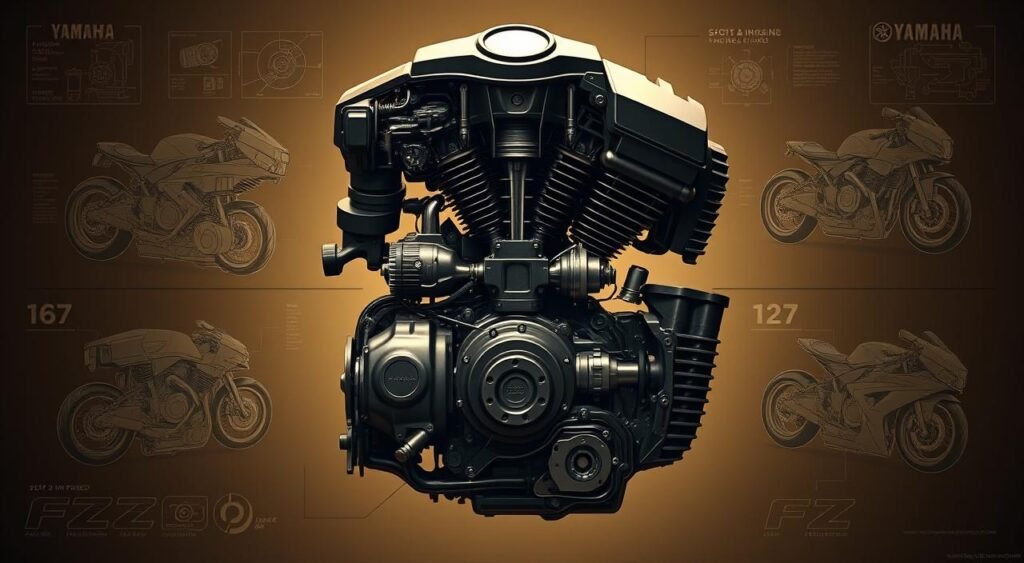
Transition to More Efficient Engines
The Yamaha FZ got a big upgrade with fuel injection. The FZ-S Fi model brought in electronic fuel injection, replacing the carburetor. This made fuel mixing better and cut down emissions a lot.
Today’s bikes have:
- Blue Core tech for better combustion
- Liquid cooling for steady performance
- Less friction parts
- Better oil flow systems
| Specification | Early FZ (2008) | Current FZ-S Fi |
|---|---|---|
| Displacement | 153cc | 149cc |
| Power Output | 14 PS @ 7,500 RPM | 12.4 PS @ 7,250 RPM |
| Torque | 13.6 Nm @ 6,000 RPM | 13.3 Nm @ 5,500 RPM |
| Fuel System | Carburetor | Fuel Injection |
| Cooling | Air-cooled | Air-cooled |
| Mileage | 45-50 kmpl | 58-60 kmpl |
The newest engines focus on fuel efficiency and low-end torque. This meets the needs of riding in Indian cities, where quick throttle response is key, not just high speed.
Design Innovations: Classic to Contemporary
The Yamaha FZ models have changed a lot over the years. They went from simple bikes to modern urban rides. The early bikes were all about being useful, not looking good. Now, they have cool designs with sharp lines and bright lights that attract young riders in India.
Aesthetic Changes in the FZ Series
The first FZ in 2008 had simple round headlights and few body parts. By 2014, Yamaha made the bikes look more aggressive with new fuel tanks and seats. The 2019 model had LED lights and strong bodywork. The latest changes include:
- Sharp, aerodynamic body panels replacing curved surfaces
- Digital instrument clusters instead of analog meters
- Metallic paint schemes with special edition graphics
- Integrated grab rails and refined tail sections
Ergonomics and Rider Comfort Improvements
Rider comfort has gotten much better over time. Yamaha worked on the handlebars, footpegs, and seats to fit different riders. The seat height went down from 795mm to 790mm, making it easier for more people to ride.
| Feature | Early FZ (2008-2013) | Current FZ (2019-2025) |
|---|---|---|
| Seat Type | Single-piece unit | Split seat design |
| Handlebar Width | 740mm | 760mm |
| Pillion Comfort | Basic grab rail | Integrated grab handles |
| Footpeg Position | Rear-set sporty | Neutral comfortable |
These changes made the Yamaha FZ better for city rides and occasional highway trips. The 2025 FZ-S Fi shows this with optimized ergonomics for daily city rides and occasional highway trips.
Safety Features: Historical vs Modern
The Yamaha FZ series has seen big changes in safety over the years. Early models had basic safety features that were common back then. Now, the FZ motorcycles have advanced safety tech, thanks to years of improvement and feedback from riders.
Safety Standards in Initial Models
Older FZ models had basic safety parts for reliability. The cheaper ones had drum brakes, while the fancier ones had single disc brakes. The main goal was to make them strong and dependable.
Early safety features included:
- Basic drum brake systems on affordable models
- Single disc brakes for higher-end variants
- Standard halogen headlights for night visibility
- Reinforced frame construction for rider protection
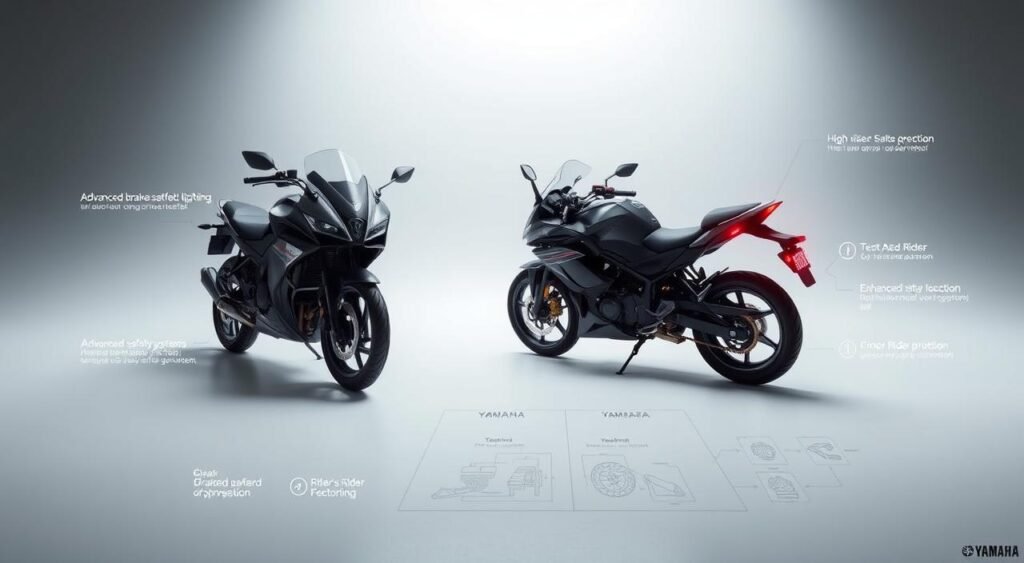
Introduction of New Technologies
Modern Yamaha FZ upgrades have brought big changes in safety. Comparing old and new FZ models shows huge leaps in braking and safety.
Today’s safety upgrades include:
- Single-channel ABS on select models for better braking
- Larger disc rotors with improved caliper designs
- LED lighting systems replacing old halogen bulbs
- Side-stand engine cut-off switches to prevent accidental starts
- Advanced tire specs for better road grip
These new features show Yamaha’s dedication to keeping riders safe while keeping the FZ’s great performance.
Performance Metrics: Past Performance vs Current
The Yamaha FZ has seen big improvements in performance over the years. Its early models set high standards for naked street bikes in India. Now, the bike offers more power and better fuel efficiency.
The switch from carbureted to fuel-injected engines was a key moment. It marked a big step forward in the bike’s performance.
Acceleration and Riding Experience Over Time
Older FZ models could go from 0 to 60 kmph in 5.5 seconds. They could reach speeds of 115 kmph. Riders felt a direct connection to the engine.
Today’s FZ bikes are just as fast but smoother. They have better throttle response and less vibration at high speeds. This makes for a more enjoyable ride.
Modern FZ bikes have better gear ratios and clutch mechanisms. This makes city rides easier and less tiring. The 2025 FZ-S Fi handles well in different weather, unlike older models.
Fuel Efficiency Improvements
Fuel efficiency has seen a big leap in the Yamaha FZ’s history. The switch to fuel injection technology made a big difference:
| Model Year | Engine Type | Mileage (kmpl) | Improvement |
|---|---|---|---|
| 2008-2014 | Carbureted | 45-48 | Baseline |
| 2014-2019 | FI Version 2.0 | 50-54 | 12% increase |
| 2019-2025 | FI Version 3.0 | 58-60 | 25% increase |
Aerodynamic changes and better engine mapping have helped improve efficiency. The latest BS6-compliant engines also meet strict emission standards. They offer better mileage than before.
Competitor Landscape: Then and Now
The Yamaha FZ bike’s world has changed a lot. It went from a simple commuter bike to a high-tech choice. Now, it’s all about performance, tech, and value.
Early Rivals in the Motorcycle Market
The FZ first hit Indian roads, facing Honda’s CB Unicorn and Bajaj Pulsar. These bikes were known for being fuel-efficient and reliable. Hero Honda also had models in the same size, but they were more for daily use.
The Yamaha FZ comparison showed it had better looks and handling. While others focused on being practical, the FZ stood out with its sporty design. This made it a favorite among those who wanted more than just a ride.
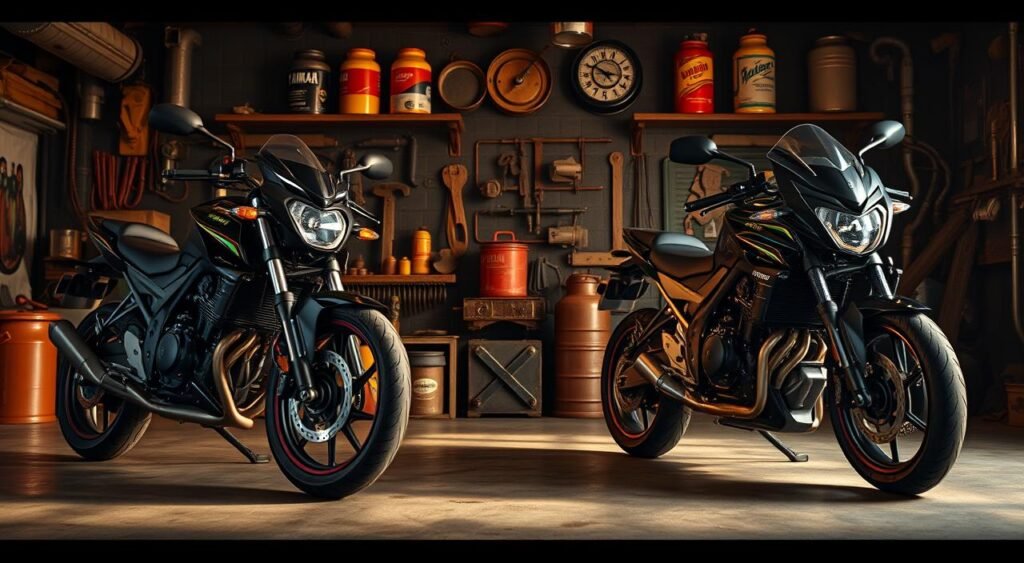
Recent Competitors and Market Position
Now, the Yamaha FZ faces even tougher competition. New rivals include:
- KTM’s affordable and powerful bikes
- TVS Apache series with cool features
- Hero Xtreme 125R for new buyers
- Honda’s updated CB lineup
The FZ stays strong thanks to updates and loyal fans. Its racing background appeals to those looking at top sports bikes in India. Its wide dealer network and reliability keep attracting customers, even with new options.
Community Culture Surrounding Yamaha FZ
The Yamaha FZ has sparked more than just rides—it has created a vibrant community. This community spans across India and beyond. Riders drawn to the distinctive style and performance of Yamaha FZ models have built lasting connections.
Formation of Riding Clubs and Cult Followings
Riding clubs dedicated to the Yamaha FZ began appearing in cities like Mumbai, Delhi, and Bangalore as early as 2009. These groups organize weekend breakfast rides, technical workshops, and modification meets. Owners showcase their customized bikes at these events.
The FZ Riders Club India, one of the largest groups, boasts over 15,000 active members. They participate in annual rides and charity events.
Local chapters maintain WhatsApp groups and organize monthly meetups at popular riding destinations. Members share maintenance tips and recommend trusted mechanics. They help newcomers navigate the world of Yamaha FZ ownership.
This grassroots movement has transformed individual riders into a tight-knit community.
The Role of Social Media in FZ Enthuasiasm
Instagram pages like @fz_nation and @yamaha_fz_official showcase stunning photography of modified Yamaha FZ models. They attract thousands of followers. YouTube channels run by enthusiasts provide detailed reviews and modification guides.
Facebook groups serve as marketplaces where members trade aftermarket parts and share technical solutions. Digital platforms have made expertise accessible to all FZ owners. A rider in Chennai can instantly get troubleshooting help from someone in Pune.
This interconnected network strengthens the bond among Yamaha FZ enthusiasts. It influences future model development through collective feedback.
Yamaha’s Commitment to Sustainability
Yamaha knows it has a big role in protecting the environment. It has made big changes in how it makes motorcycles. The Yamaha FZ evolution is a big step towards being kinder to the planet without losing performance.
The company works hard to make its production green. It looks at everything from how it makes parts to how it meets emission standards. Yamaha keeps finding new ways to be eco-friendly in its factories.
Environmentally Friendly Practices Over the Years
The Yamaha FZ upgrades have always aimed to cut down on pollution. At first, they used carburetors, but switching to fuel injection was a big win for the environment. This change cut hydrocarbon emissions by up to 40% and made the bikes more fuel-efficient.

- Installation of solar panels at production facilities
- Water recycling systems saving millions of gallons annually
- Reduced packaging materials by 25% in five years
- Catalytic converter adoption across all FZ models
Future Initiatives for Eco-Friendly Production
Yamaha is setting big goals for the future of the Yamaha FZ evolution. It wants to be carbon neutral by 2050. The company is working on making its production better and its supply chain greener.
Alternative fuel compatibility is also a focus. Yamaha is testing bikes that run on ethanol blends and electric powertrains. This is all part of its plan to make motorcycles even more eco-friendly.
| Sustainability Initiative | Current Status | 2030 Target |
|---|---|---|
| Carbon Emissions | 30% reduction | 60% reduction |
| Recyclable Materials | 75% of components | 95% of components |
| Renewable Energy Use | 40% of facilities | 80% of facilities |
Customer Support and Service Evolution
The way Yamaha FZ customer support has changed shows a big shift in how bikes are sold and serviced. It moved from simple dealer talks to advanced online services. This change has greatly improved how customers are treated.
Early Customer Support Practices
In the early days of the Yamaha FZ, support was mainly through dealerships. Shops had basic tools and not many spare parts. Mechanics used paper records and manual systems for warranties.
Customers faced long waits for parts and uneven service quality. This was true across different places.
Modern Advancements in Customer Care
Now, the support for Yamaha FZ has seen big changes. The digital world has changed how riders deal with service centers. Yamaha Blue Square outlets offer the same quality everywhere.
Mobile apps let riders book services and track their bikes easily. This makes things faster and more convenient.
| Service Feature | Early 2000s | Current (2024) |
|---|---|---|
| Booking Method | Phone/Walk-in | Mobile App/Online Portal |
| Service Records | Paper Documents | Digital Database |
| Parts Availability | 2-4 Weeks Wait | 24-48 Hours |
| Technician Training | Annual Workshops | Continuous Online Modules |
| Customer Feedback | Suggestion Box | Real-time Digital Surveys |
Today, advanced tools help fix bikes quickly. Parts get to customers fast thanks to a central system. Predictive inventory management makes sure parts are always ready.
Feedback has changed from simple boxes to online surveys. This lets Yamaha keep improving its service.
The Future of the Yamaha FZ Series
The Yamaha FZ series is set to welcome new tech while keeping its unique feel. Riders will soon see big changes in how they connect with their bikes. Smartphones and advanced screens will change the game, giving riders real-time info on performance and more.
Expected Trends in Design and Technology
Expect the Yamaha FZ to get a sleeker look and better aerodynamics. It will use top-notch materials like carbon fiber and alloys to be lighter and stronger. Features like traction control and different riding modes will become common. This shows how the Yamaha FZ is moving towards smarter, safer bikes that adjust to any ride.
Predictions for Market Position in the Coming Years
The Yamaha FZ will stay ahead by mixing low prices with high-tech features. It might even add electric and hybrid models as India seeks greener transport. Its trustworthiness and value will keep it strong against Honda CB Hornet and Bajaj Pulsar. Experts say the Yamaha FZ will grow its spot in the entry-level market with tech usually found in pricier bikes.
FAQ
What are the main differences between early Yamaha FZ models and the 2025 FZ-S Fi?
Early Yamaha FZ models had air-cooled engines and carburetors. They produced 13-14 PS power and had basic features. The 2025 FZ-S Fi has liquid cooling, fuel injection, and LED lights. It also has digital displays and produces 12.4 PS with 13.3 Nm torque. It gets about 60 kmpl, better than the early models’ 45-50 kmpl.
How has the Yamaha FZ evolution impacted its performance metrics?
The Yamaha FZ evolution has kept the 0-60 kmph time at 5-6 seconds. It has improved mid-range performance and vibration isolation. Modern models offer smoother power delivery and better thermal management. They also provide enhanced riding comfort compared to the early models.
What major Yamaha FZ upgrades occurred from 2006 onwards?
From 2006, the Yamaha FZ got fuel injection, liquid cooling, and LED lights. It also got digital displays and better chassis designs. Recent models have variable valve actuation, traction control, smartphone connectivity, and single-channel ABS.
How does the current Yamaha FZ comparison fare against competitors?
The current Yamaha FZ compares well against rivals like Hero Xtreme 125R and TVS Raider. It’s known for reliability, a wide dealer network, and updates. The 2025 FZ-S Fi offers advanced features and about 60 kmpl fuel efficiency at a competitive price.
What are the key Yamaha FZ changes in design philosophy?
The Yamaha FZ design has changed from utilitarian to sophisticated urban motorcycles. It now has sharp bodywork, muscular fuel tanks, LED lights, and aerodynamic enhancements. It keeps its aggressive styling heritage.
Which Yamaha FZ models have been most significant in the series history?
Key Yamaha FZ models include the original air-cooled variants and the 2006 fuel-injected versions. The FZ-S variant added comfort features. The 2025 FZ-S Fi is the latest evolution with 12.4 PS power and modern connectivity.
How has Yamaha FZ history influenced motorcycle culture?
Yamaha FZ history has built strong owner communities through clubs and online forums. The model’s modification culture has grown with aftermarket parts. Annual meets and digital platforms strengthen bonds, influencing future models and creating cultural impact.
What can we expect from the future Yamaha FZ bike development?
Future Yamaha FZ bikes may have advanced rider assistance systems and connectivity features. They might include electric or hybrid variants and better fuel efficiency. Expect traction control, riding modes, digital displays, and IoT integration while keeping performance and value.
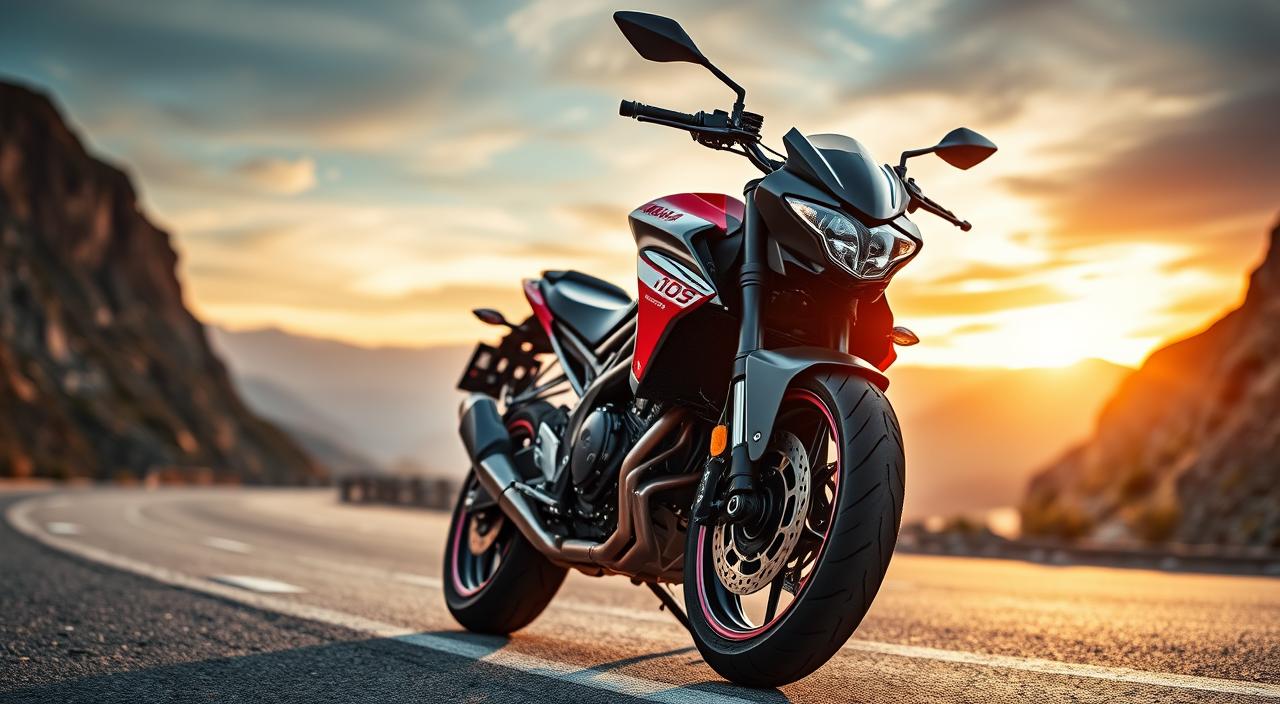
Feb
Can a lightweight naked sports bike offer the best mix of bold looks and strong power? The Yamaha MT-03 tries to answer this with its cool features and spot in Yamaha’s hyper naked lineup. This 660cc parallel-twin engine bike promises a thrilling ride for both new riders and city commuters looking for a budget-friendly, high-performance bike.
The MT-03 has a liquid-cooled, inline two-cylinder engine with 321cc. It gives smooth power at low speeds and strong performance at high speeds. The six-speed transmission has different gear ratios for various riding conditions. The inverted KYB® front fork and adjustable single-shock design balance comfort and performance.
Yamaha’s dynamic mass forward design, seen in their Hyper Naked bikes, boosts looks and performance. The powerful LED headlight and turn signals improve visibility and light up the road. The MT-03’s light weight and strong power make for an exciting ride.
Key Takeaways
- The Yamaha MT-03 is a lightweight naked sports bike that combines aggressive styling with powerful performance.
- It features a 321cc liquid-cooled, inline two-cylinder engine with smooth power delivery and strong performance at high rpms.
- The inverted KYB® front fork and adjustable rear shock provide a balance between comfort and performance.
- The MT-03’s seat height of 30.7 inches makes it accessible to a wide range of riders, including beginners and urban commuters.
- Yamaha’s dynamic mass forward design enhances the MT-03’s aesthetics and performance, while the LED lighting contributes to its aggressive styling.
Introduction to the Yamaha MT-03
The Yamaha MT-03 is a naked motorcycle that offers power, performance, and style at a good price. It’s great for city rides and weekend adventures. It’s perfect for those who want affordable performance.
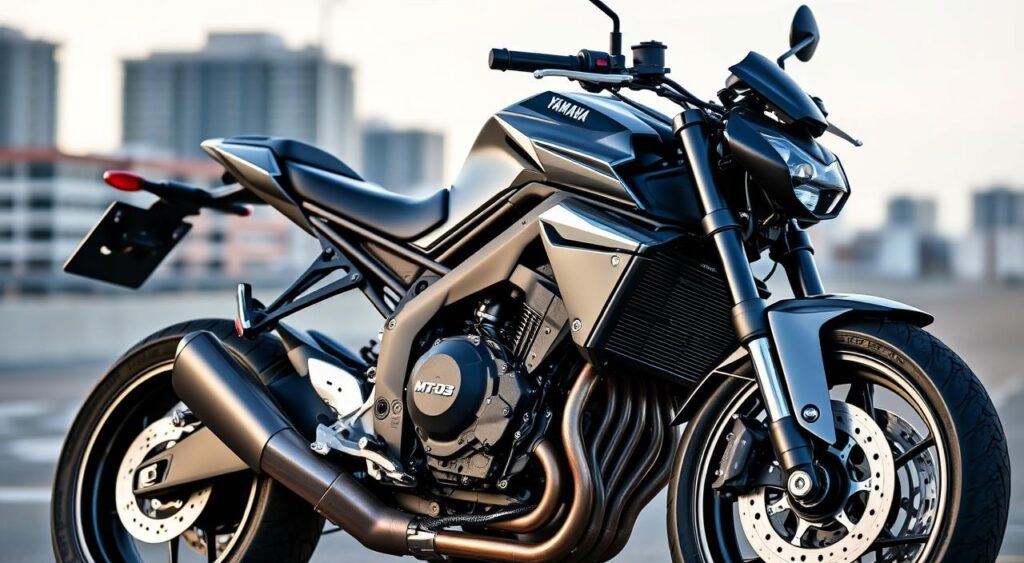
Key Features of the Yamaha MT-03
The MT-03 has many cool key features, including:
- 321cc liquid-cooled parallel-twin engine producing 42PS at 10,750rpm and 29.6Nm at 9,000rpm
- LED lighting and an LCD instrument console
- Dual-channel ABS for enhanced safety
- Comfortable riding position and agile handling
The engine is based on the R3, known for its high-revving excitement. It starts to show its power at 7,000rpm and goes up to 12,000rpm. The MT-03 is fuel-efficient, getting 25 km/l in the city and 37 km/l on highways. It has a 14-liter tank, allowing a 410 km range.
The MT-03 in Yamaha’s Hyper Naked Range
The MT-03 is a budget-friendly option in Yamaha’s hyper naked range. It’s a great choice for those new to naked motorcycles. Even though it’s pricier than some rivals, it offers a mix of performance and style.
| Motorcycle | Price (On-Road, New Delhi) |
|---|---|
| Yamaha MT-03 | ₹ 5.45 lakh |
| Aprilia RS 457 | ₹ 40,000 cheaper than MT-03 |
| KTM 390 Duke | ₹ 1 lakh cheaper than MT-03 |
The MT-03 is great for riders who are shorter, thanks to its low seat. But taller riders might find it a bit cramped. The bike’s suspension works well on smooth roads but can struggle on bumpy ones.
Engine and Performance
The Yamaha MT-03 has a powerful 321cc parallel-twin engine. It’s based on the Yamaha YZF-R3. This engine gives 42 horsepower at 10,750 rpm and 22 ft-lb of torque at 9,000 rpm. It’s great for both new and experienced riders.
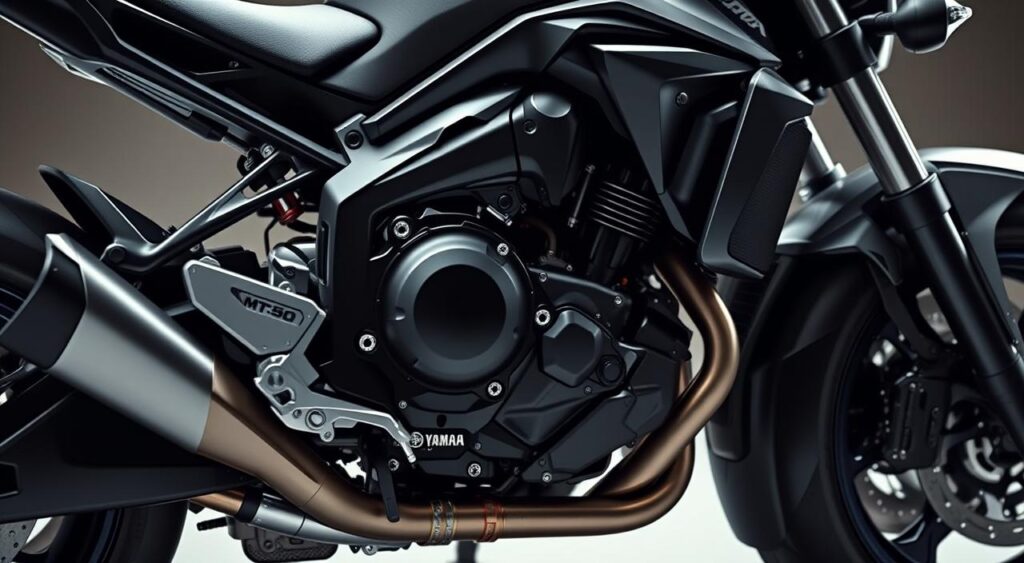
The MT-03’s 660cc engine is made for smooth power delivery. It accelerates smoothly from start to finish. It goes from 0-60 mph in 5.11 seconds and the quarter-mile in 14.05 seconds at 92 mph. It’s as fast as the Kawasaki Z400, Honda CB300, and KTM Duke 390.
Power and Torque Figures
The Yamaha MT-03’s parallel-twin engine has impressive specs:
| Specification | Value |
|---|---|
| Maximum Power Output | 41 horsepower |
| Maximum Torque | 21.8 ft-lb |
| Engine Displacement | 321cc |
| Claimed 0-60 mph Time | 5.1 seconds |
| Comfortable Cruising RPM at 70 mph | Around 7,000 rpm |
These numbers mean the MT-03 is both fun and easy to handle. It’s perfect for those moving up from smaller bikes or looking for a bike for city rides and weekend trips.
Fuel Efficiency and Range
The Yamaha MT-03 is also great on fuel, making long trips easier. It can go over 200 miles on a tank. This makes it a smart choice for daily rides and longer trips.
Handling and Agility
The Yamaha MT-03 shows Yamaha’s dedication to a perfect mix of power and agility. It has a lightweight frame. This makes it easy to handle in cities and rural areas.
Lightweight Chassis and Maneuverability
The MT-03’s agility comes from its lightweight diamond frame. It weighs just 167 kg, making it one of the lightest. It’s as light as the KTM Duke 390 and Kawasaki Z400.
The bike’s compact design and short wheelbase of 1,380 mm make it easy to turn. It’s perfect for navigating tight spaces.
Suspension Setup and Ride Quality
The Yamaha MT-03 has a top-notch suspension setup. It has a 37 mm inverted KYB® fork and a monoshock that can be adjusted in seven steps. This setup smooths out bumps, making the ride comfortable and stable.
The bike’s 160 mm ground clearance lets it handle different road conditions well. It doesn’t lose its handling ability.
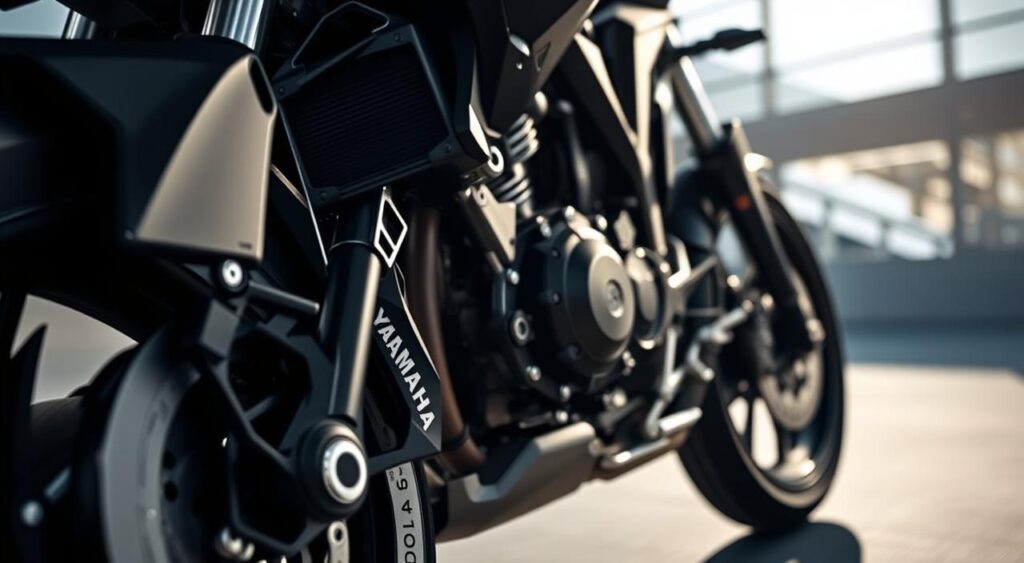
Braking Performance and Safety Features
Safety is key, and the Yamaha MT-03 excels in this area. It has dual disc brakes: a 298 mm disc at the front and a 220 mm disc at the rear. This gives riders the confidence to stop safely.
The MT-03 also has a dual-channel ABS system. This prevents wheels from locking up and ensures safe braking in all conditions.
The Yamaha MT-03 is a standout in the hyper naked bike category. It’s great for city streets and twisty roads. It offers an exciting and safe ride.
Yamaha MT-03: Style and Design
The Yamaha MT-03 shows off the brand’s aggressive design language. It has a muscular fuel tank, sharp lines, and compact proportions. This bike is perfect for those who want a bold and edgy look.
The MT-03’s front looks sharp with a single LED headlight and LED DRLs. It has an exposed engine and underbelly exhaust. These features make it look raw and sporty.
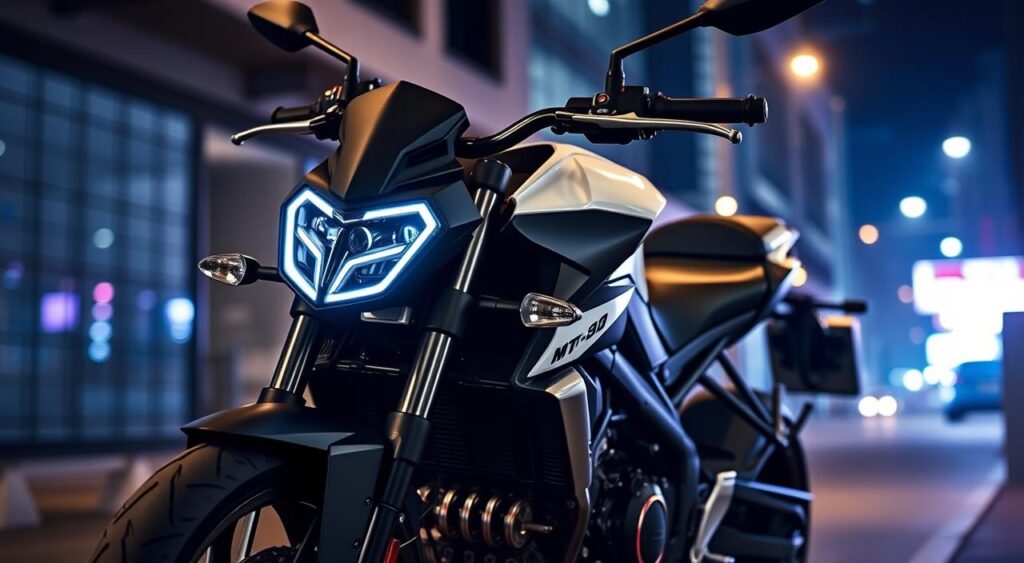
Yamaha made the MT-03 with streetfighter styling in mind. It’s small and easy to handle in the city. The bike comes in many colors to match different tastes.
Compared to the Yamaha YZF-R3, the MT-03 is more comfortable. It has higher handlebars and lower footpegs. This makes it great for daily rides and city streets, while keeping a sporty vibe.
| Specification | Yamaha MT-03 | Yamaha YZF-R3 |
|---|---|---|
| Ex-showroom Price (Delhi) | ₹3,49,900 | ₹3,59,900 |
| Engine Type | 4-stroke, Liquid-cooled, DOHC, 4-valves | 4-stroke, 2-cylinder, Liquid-cooled, DOHC, 4-valves |
| Max Power | 42 PS @ 10,750 rpm | 42 PS @ 10,750 rpm |
| Max Torque | 29.5 Nm | 29.5 Nm |
| Mileage | 26.31 kmpl | 25 kmpl |
| User Review Score | 4.5/5 (26 reviews) | 4.3/5 (10 reviews) |
In summary, the Yamaha MT-03 is a stylish and powerful entry-level bike. Its aggressive design, muscular fuel tank, and sporty stance make it a great choice.
Conclusion
The Yamaha MT-03 is a great pick for those new to biking but want power. It has a beginner-friendly design yet packs a punch. Its 321cc engine gives it a strong performance, reaching speeds of 160 km/h.
The MT-03 is also light and easy to handle. This makes it perfect for city rides and winding roads. It’s a bike that’s both fun and easy to ride.
Even though it’s priced well, the MT-03 doesn’t skimp on quality. It has a big fuel tank and good fuel efficiency. This bike is comfy and easy to get used to, making it great for new riders.
Its design is stylish, and it’s built with Yamaha’s high standards. This bike is a hit with both new and seasoned riders. It offers a lot of fun without breaking the bank.
While it might not have all the bells and whistles of pricier bikes, the MT-03 is reliable and exciting to ride. Its affordable price, low upkeep, and Yamaha’s quality make it a top choice. It’s a great way to dive into the world of naked sports bikes.
FAQ
What kind of engine does the Yamaha MT-03 have?
The Yamaha MT-03 has a 660cc parallel-twin engine. It’s based on the Yamaha R3. This engine gives strong torque in the low and mid-range, making it great for city rides and highway cruising.
Is the Yamaha MT-03 beginner-friendly?
Yes, it’s perfect for new riders. It has a lightweight chassis, comfy ergonomics, and easy power delivery. This makes it simple to handle and ride.
What is the fuel efficiency of the Yamaha MT-03?
The Yamaha MT-03 gets about 30kmpl. It has a 14-liter tank, so you can go over 400km on one tank. It’s great for city trips and longer rides.
Does the Yamaha MT-03 come with ABS?
Yes, it comes with dual-channel ABS as standard. This ensures safe stops, even in tough conditions.
What are the key features of the Yamaha MT-03?
The Yamaha MT-03 has many cool features. It has a 660cc parallel-twin engine, LED lights, an LCD console, and ABS. It also has a lightweight frame and an aggressive design. These features make it perform well, handle great, and look awesome.
Is the Yamaha MT-03 suitable for both urban commuting and weekend rides?
Yes, it’s made for both city driving and weekend fun. It has a comfy ride, agile handling, and a strong engine. It’s perfect for city streets and weekend adventures.
